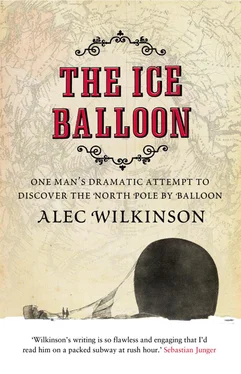No photographs I am aware of show Andrée using the portable electrometer, but from the directions for its use, contained in the paper “Instructions for the Observation of Atmospheric Electricity,” by Lord Kelvin, published in 1901, it is easy to imagine a solitary figure in the daylight of an Arctic summer standing by a tripod about five feet tall. The tripod is not less than twenty yards from any structure that rises above it (“such as a hut or a rock or mass of ice or ship,” Kelvin wrote). To prevent sparks from static electricity leaping from his fur cap or his wool clothes he has covered the cap and his arms with tinfoil attached to a fine wire he holds in the hand that touches the electrometer. The electrometer has its own metal wire to which a lit match is attached, and while the match burns he makes readings by keeping a hair between two black dots, which he has sometimes to squint to see. Andrée performed the task with such resourcefulness, overcoming technical complications that defeated some of the other nations, and so assiduously—he made more than fifteen thousand observations—that the Swedish findings were considered the best among all the nations.
The International Polar Stations, 1882–1883
Courtesy of the Newberry Library, Chicago.
According to The Andrée Diaries, “Andrée also endeavored to find a correlation between the simultaneous variations of aero-electricity and geo-magnetism. “This has been hard work,” he wrote Dahlander, “for it has been necessary to calculate about 5000 values of the total intensity of geo-magnetism.” Meanwhile he made notes about the patterns of drifting snow, which he published in 1883 in “Drift Snow in the Arctic.” Furthermore, to determine whether the yellow-green tinge that appeared in a person’s face at the end of the Arctic winter was a result of the person’s skin having changed color in the dark or of his eyes’ having been affected by the arriving light, Andrée allowed himself to be shut indoors for a month. When he finally went out, it was clear that the pigmentation of his skin had changed. Before his confinement, Andrée wrote, “Dangerous? Perhaps. But what am I worth?” His diligence did not seem to make him well liked, however. His journals often mention that the others are not doing their work properly or are misbehaving, and that he is the only one comporting himself correctly.
“What shall I do when I come home?” Andrée wrote in his journal. In 1885 he was made head of the Technical Department of the Swedish Patent Office in Stockholm, a position he held until he left for the pole. As a kind of ambassador for science and new technology, he traveled in Europe looking for useful patents—he went to the world’s fairs in Copenhagen and in Paris, in 1888 and 1889—especially patents that might reduce drudgery for people who did factory work; he had a social conscience and a conviction that science and new inventions ought to make life less burdensome, that the most useful innovations were applied ones. If people’s lives were easier, he believed, they would be happier, and society would be better, with the result that there would be even more innovations. The man he worked for liked him but thought he was stubborn. He was amused at having pointed out to Andrée that while laws and regulations sometimes prohibited innovations they were nevertheless essential, and having Andrée reply that any law that prevented an innovation was wrong. Andrée’s personality was forceful, and his approach to social and legal change was not subtle. A few years before he left for the pole, he was a member of the municipal council and introduced a motion that the day for people who worked for the city should be reduced to ten hours from twelve, and that the women’s day should be eight hours instead of ten. The proposal failed quickly, and before long, and largely as a consequence, Andrée lost his position on the council.
Between 1876 and 1897 when Andrée left for the pole, the telephone, the refrigerator, the typewriter, the matchbook, the escalator, the zipper, the modern light bulb, the Kodak camera, the gasoline combustion engine, Coca-Cola, radar, and the first artificial textile (rayon) were invented; the speed of light was determined; X rays were first observed and radiation detected in uranium; and Freud and the Austrian physician Josef Breuer began psychoanalysis with the observation in a paper that “Hysterics suffer mainly from reminiscences.” Almost quaintly, Andrée embraced modernity by trying to use a half-ancient conveyance in an innovative way.
The first balloon plans patented were patented in Lisbon in 1709 by a Jesuit father named Bartolomeu Gusmão. From a balloon, cities could be attacked, he said; people could travel faster than on the ground; goods could be shipped; and the territories at the ends of the earth, including the poles, could be visited and claimed.
Seventy-four years later the first balloon left the ground with passengers, in France. It was built by the Montgolfier brothers, Joseph-Michel and Jacques-Étienne. As children they had observed that paper bags held over a fire rose to the ceiling. Using hot air, their first balloon went up without passengers in the country. Their next went up from Paris with a sheep, a duck, and a rooster, because no one knew what the effect of visiting the upper atmosphere would be, or if there was any air in the sky to breathe. Their third balloon went up with two people. The king wanted the first passengers to be criminals, who would be pardoned if they lived, but he was persuaded that a criminal was unworthy of being the first person in the air, and two citizens went instead.
The hydrogen balloon was developed almost simultaneously by a member of the French Academy named Jacques Charles, who had heard of the Montgolfier brothers’ first balloon and mistakenly thought it had used hydrogen. From the place where the Eiffel Tower now is, he sent up a balloon thirteen feet in diameter, also in 1783. Benjamin Franklin was among the audience. The first balloon to go up in England went up in 1784, and the first to crash, when its hydrogen caught fire, crashed in France in 1785.
George Washington watched the first American ascent, in 1793, by a Frenchman who flew from Philadelphia to a town in New Jersey, which took forty-six minutes. Probably the first ascent north of the Arctic Circle was made by a hot-air balloon in July of 1799, built by the British explorer Edward Daniel Clarke, who was visiting Swedish Lapland. He planned the ascent as a kind of spectacular event, “with a view of bringing together the dispersed families of the wild Laplanders, who are so rarely seen collected in any number.” Seventeen feet tall and nearly fifty feet around, and made from white satin-paper, with red highlights, the balloon was constructed in a church, “where it reached nearly from the roof to the floor.” To inflate it Clarke soaked a ball of cotton in alcohol and set the cotton on fire.
The balloon was to go up on July 28, a Sunday, after Mass. The Laplanders, “the most timid among the human race,” Clarke wrote, were frightened by the balloon, “perhaps attributing the whole to some magical art.” The wind was blowing hard, and Clarke thought it would ruin his launch, but so many Laplanders had showed up he “did not dare to disappoint them.” The Laplanders grabbed the side of the balloon as it was filling, and tore it. They agreed to remain in town, with their reindeer, while it was mended. Meanwhile “they became riotous and clamorous for brandy.” One of them crawled on his knees to the priest to beg for it.
When the balloon was released that evening, the Lapps’ reindeer took off in all directions, with the Lapps running after them. It landed in a lake, took off again, then crashed. The Lapps crept back into town.
Читать дальше












